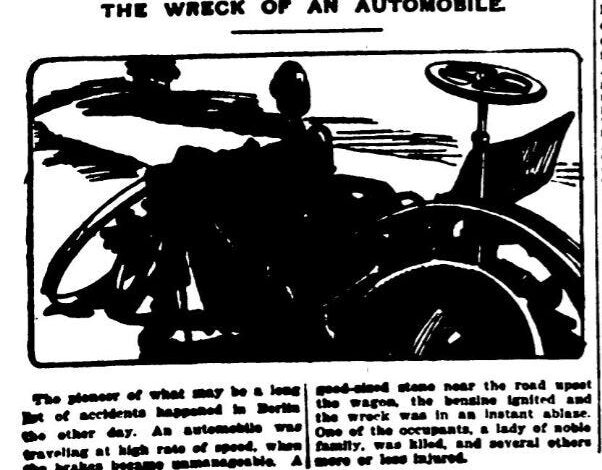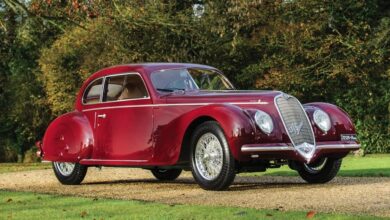The News covered several firsts and oddities when automobiles hit the streets

This story is part of a look back at 150 years of crime coverage from The Detroit News. Check this page on weekends for periodic new material involving long-lost cases and other interesting tidbits from the News archives.
The Detroit Metropolitan Police Commission met Aug. 20, 1897, to discuss purchasing horses for the city’s Police Department, and when the board balked at the cost of $100-$150 per animal, Commissioner Ralph Phelps suggested an alternative.
“Phelps … thought that the time was fast approaching when horses would be a curiosity and the department use an automobile for patrol wagons,” The Detroit News reported.
It would be more than 10 years before the commissioner’s forecast would come true. Phelps’ prediction came just a year after Charles Brady King drove the first gasoline-powered automobile in downtown Detroit on March 6, 1896, and it would be a few years into the 20th century before the invention would be considered much more than a plaything for daredevils and the rich.
But as cars became more ubiquitous in Detroit, their uses — and headaches — began to dawn on police and the journalists who covered them.
The News recorded several firsts and oddities related to the machine that would change the world and put Detroit on the map.
Early crashes
The News’ Dec. 3, 1899, edition carried a photo of a mangled car titled “The Wreck of An Automobile,” with the caption reporting details about a fatal car crash in Berlin, Germany. The News said the incident, which made international headlines, was “the pioneer of what may be a long line of accidents.”
The prediction played out less than a week later, when on Dec. 8, 1899, a streetcar struck an automobile on Jefferson Avenue and Orleans near downtown — the first Detroit auto crash covered by The News.
“Automobilist” George Weber of Detroit was headed to Belle Isle with his 57-year-old mother and 4-year-old niece in the car, when he told The News he drove onto the Jefferson trolley track to navigate around a line of wagons that were blocking the street.
Weber said he didn’t see the Lake Shore & Mount Clemens streetcar until it was too late.
“In his attempt to turn the vehicle the wheels slipped, and a moment later the wreck of the automobile and three human forms were stretched out upon the pavement,” The News reported the next day.
Weber’s mother, Elizabeth Weber, suffered a double skull fracture and was taken to St. Mary’s Hospital, where doctors told The News she had “scarcely any chance of life.”
Despite the prognosis, the patient recovered after lying in a coma for nine days. That left the distinction of being Detroit’s first auto-related death to 81-year-old George W. Bissell three years later.
Bissell, a wealthy shipping magnate, was riding in a horse-drawn carriage on Brooklyn Avenue when “his spirited team became frightened at the rapid approach of an automobile,” The News reported on Sept. 2, 1902, hours after the incident. The horses bolted forward, and “at that moment, the wheel of his carriage came off,” The News said. “Mr. Bissell was thrown violently to the pavement.”
Bissell died in Harper Hospital two hours later.
A year after Bissell’s death, on March 10, 1903, legendary racing pioneer Barney Oldfield was driving his “Baby Bullet” Winston automobile at nearly 60 mph on the Grosse Pointe Track, when the car’s tire blew out and the vehicle smashed through a fence, killing spectator Frank Shearer.
On Oct. 6, 1903, Michigan Sen. Frank Glazier had several people in his car when he lost control during a curve on McDougall on Detroit’s east side, jumped the curb and slammed into a tree. Lucy Mudge of Albion was killed in what The News called “one of the most unfortunate automobile accidents that ever occurred on a Detroit thoroughfare.”
As automobile crashes continued, Detroit officials began clamoring for laws restricting their use.
Calls for regulation
In 1901, after Alderman Richard P. Joy suggested the city enact an ordinance regulating the speed of automobiles, The News expressed outrage about the nonexistent oversight.
“The lack of actual regulation at present, either for bicycling, automobiles or vehicles of any kind, is a state of affairs which few cities outside Detroit tolerate,” The News opined on March 22, 1901.
There still wasn’t an auto ordinance by Aug.14, 1902, although according to that day’s edition of The News, the City Council had set a meeting to discuss a proposed set of rules governing the noisy oddity that was increasingly showing up on city streets.
“The ordinance provides for a speed of six miles an hour in the center of the city and 12 miles an hour on some of the streets farther out,” The News explained. “Violators of the ordinance are to be subject to fine of $25 and suspension of the license for 30 days for the first offense, and for the second offense the same fine will be imposed and the license revoked for a year.”
The proposed ordinance also required license plates that would need to be renewed each year for $5. The plates were “to be placed on the front of each lamp, and in a conspicuous place on the back of the vehicle,” The News reported.
The automobile ordinance finally passed and went into effect Dec. 1, 1903 — but it apparently didn’t do much good because the following year the City Council passed a resolution begging DPD to start enforcing the new rules for “automobilists.”
Not everyone embraced the new oversight. On April 19, 1904, The News reported that auto pioneers Henry Ford, John F. Dodge and H.E. Dodge had filed a lawsuit challenging Detroit’s automobile ordinance.
“They claim it is unconstitutional because it discriminates between the owners of automobiles and the owners of other vehicles by compelling the former to pay a license and display numbers of their machines, and because the imposing of a license amounts to double taxation of personal property,” The News reported.
To the chagrin of future generations of Detroiters who would wait in line at Michigan Secretary of State’s offices to renew their plates and pay for the privilege, the lawsuits went nowhere.
Squad car firsts
In 1899, Akron, Ohio became the first city in the United States to use an automobile for police work, although the electric patrol wagon was junked after a few years.
Detroit Police are credited with deploying the first modern police vehicle, which happened at the behest of Police Commissioner Frank Croul, who had such faith in the automobile’s ability to help law enforcement, he dug into his own pocket.
For years, Croul had asked the City Council to approve funds to purchase automobiles for DPD. Finally, in 1909, he bought a Packard for $350 — about $12,000 in 2024 dollars — and donated it to the police department.
In July, 1910, the council finally approved the purchase of seven cars and a truck for DPD, although the vehicles wouldn’t hit the road until Jan. 7, 1910. The next day, The News reported that the first person to officially be thrown into a DPD squad car was Henry Calhoun, who was picked up for public drunkenness.
Police Court Judge Edward L. Jeffries — father of his namesake who would become Detroit mayor — heard the case.
“The first to ride in the auto patrol, eh?” the judge said, according to The News. “Well, I feel that I auto let you go in view of that.”
“Then Henry arose and went on his way, pondering the judicial pun,” The News said. “He was the only man arrested last night and given a ride in the auto patrol who remembered the experience.”
First responders exempted
The city was still working out the kinks in its regulation of automobiles in 1913. Five years after the Model T was introduced, police and firefighters were still required to obey the speed limit, even when responding to emergencies.
In January 1913, Croul asked the City Council for Detroit’s police and fire departments and the Wayne County Sheriff’s Office to “be exempted from the ordinance limiting the rate of speed at which automobiles may drive through the streets of the city,” The News reported.
Croul’s request was made during a dispute with the Detroit Ambulance Co., according to The News.
“This unpleasantness was caused by Commissioner Croul’s insistence that the ambulance company violate the speed laws less,” the News said. “He held that drivers of this company were breaking the law when there was no emergency to justify them. As a result, he caused the company to be heavily fined recently in the recorder’s court.
“The ambulance company head then discovered that the police department itself has no right under the ordinance to exceed the prescribed speed limits and retaliated by bringing suit against it,” The News reported. “The police driver named was convicted. Sentence was suspended so the commissioner could take the matter up with the council.”
Croul told the council: “If the police and fire departments and the sheriff are forced to obey the speed regulations, we may as well go out of business. It was never intended we should not have special permission to use high speed in emergencies.”
Croul’s request was granted, and first responders have sped to emergencies ever since.
ghunter@detroitnews.com
(313) 222-2134
@GeorgeHunter_DN



